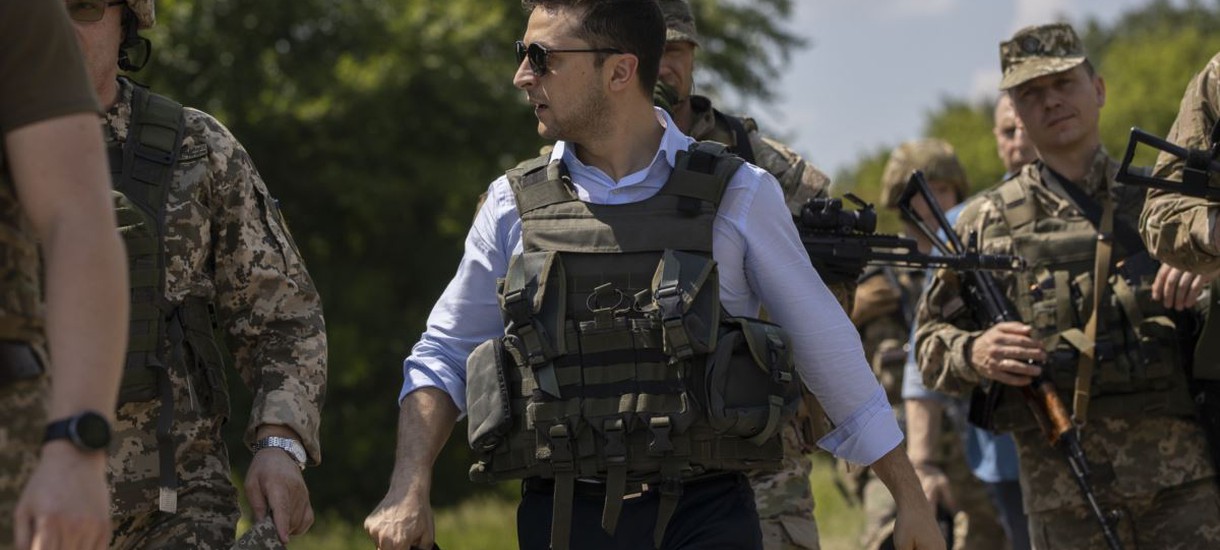After the election of the sixth President of Ukraine, Volodymyr Zelensky, a “window of opportunity” opened for speeding up the peace process in the East of the country. Zelensky often called himself “the president of peace”, promised to end the conflict in Donbas during his tenure, and emphasized the need for dialogue with all parties. Ending hostilities was one of Ukrainian citizens’ main expectations from the new president, and he received an unprecedented mandate from voters to address the issue. A little over one year later, however, it can be said that the window of opportunity has largely closed, with the prospect of a peaceful settlement remaining uncertain and vague.
What changed
Some positive dynamics in resolving the conflict over the past year should be noted. Direct negotiations were held between the presidents of Ukraine and Russia, the first meeting since 2016 in the Normandy format, along with three exchanges of detainees and troop disengagements at three points of confrontation – Zolote, Petrovsky, and Stanytsia Luhanska.
Yet as of June 2020, implementation of the agreements reached at the Paris summit remains wanting:
- A complete ceasefire never happened.
- The demining plan has not yet been approved – according to statements of the Ukrainian participants in the Minsk Trilateral Contact Group, the locations of humanitarian demining have only been partially agreed upon.
- Three new areas of troop disengagement have not yet been coordinated.
- Prisoner exchanges were held twice after the summit, in December and April, but the exchange of “all for all” has not yet taken place.
- The International Red Cross does not have access to all detained persons in the self-proclaimed “Luhansk People’s Republic” and “Donetsk People’s Republic” (hereinafter L/DPR).
- According to statements of the Minsk Trilateral Contact Group participants, an agreement on new checkpoints across the demarcation line has been reached, but they have not yet been opened.
- The updated law “On the Peculiarities of Local Self-Government in Certain Areas of Donetsk and Luhansk Regions” has not been approved. The Steinmeier Formula has not been implemented into Ukrainian legislation.
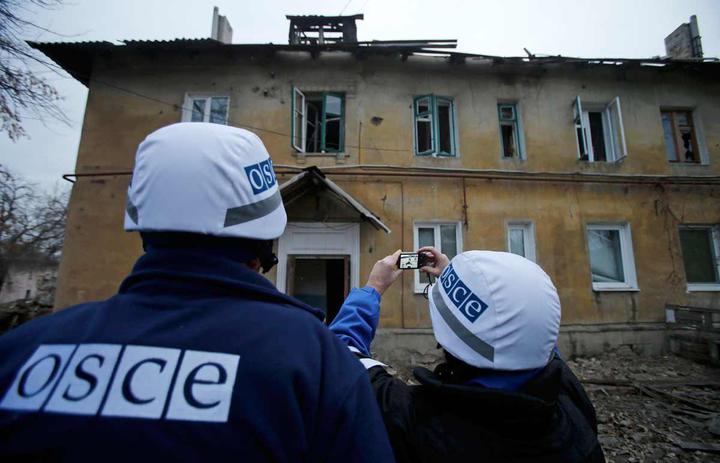
The expansion of the OSCE mandate, agreed upon at the summit, also did not happen. Moreover, with the beginning of the quarantine, L/DPR authorities cut off access for representatives of the OSCE monitoring mission for several months. Restrictions on the movement of OSCE representatives in the conflict zone is an obstacle to monitoring the ceasefire. This is also one of the reasons why the OSCE reports do not provide a complete picture. Nevertheless, it is the most neutral and objective source of information on the situation in the conflict zone and what has changed along the demarcation line during this time.
Restrictions on the movement of OSCE representatives decreased in 2019, but only at the expense of the side controlled by Kyiv. In 2019, 92 percent of such cases were recorded in uncontrolled territory and 8 percent in controlled territory, while in 2018 the figure was 83 percent and 17 percent, respectively. A similar picture emerges concerning the placement of weapons in violation of the ceasefire. In 2019, 75 percent of such weapons were recorded from the uncontrolled side and 25 percent from the controlled side (57 percent and 43 percent in 2018, respectively). In the second quarter of 2020, the ratio was already 85 percent to 15 percent.
The number of ceasefire violations in 2019 compared to 2018 decreased by 4 percent. But this decrease was only due to the third quarter (the first, second, and fourth quarters of 2019 witnessed increases compared to 2018) and is the result of the signing of the most successful ceasefire in the last few years on 21 July 2019. Unfortunately, its effect was short-lived, sabotaged by the death of four Ukrainian Marines on 6 August. In 2020, the number of ceasefire violations fell compared to 2019 (by 25 percent in the first quarter of 2020 compared to the fourth quarter of 2019), but at the same time, the intensity of the use of weapons that should have been withdrawn increased (seven times more compared to the fourth quarter of 2019) – although the OSCE did not report which side was more likely to violate the ceasefire.

According to the reports of the UN monitoring mission, the number of civilian casualties in 2019 decreased by 33 percent compared to 2018 (from 281 to 167, including both killed and wounded). Most civilian casualties as a result of artillery shelling and small arms fire were recorded in the territories controlled by the L/DPR, and are likely attributable to the Government of Ukraine, based on the geographic location where they occurred. This marks a continuation of the trend from the last years of Poroshenko’s presidency: in 2019, 81 percent of such victims were in uncontrolled territories and 17.1 percent in controlled territories, in 2018 that figure was 78.3 and 17.2 percent. It should be kept in mind that the ratio of victims also depends on population density on both sides of the front line (it is higher in the L/DPR territories on the front-line zone) and other factors. The number of civilian casualties in the first six months of 2020 corresponds to about half of the number of casualties in 2019.
In general, the general trend towards a gradual decrease in the intensity of hostilities and the number of military and civilian losses continues, albeit slowly. Moreover, periodic exacerbations on the front line threaten to interrupt this trend at some point.
Who Opposes the Peace Process?
From the very beginning, Zelensky’s peace initiatives met with resistance from part of the political forces and the public, who labelled them “surrender”. After Ukrainian authorities agreed to the Steinmeier formula, protests ignited with the active participation of the far-right. From the parliamentary parties, the protests were supported by the “European Solidarity” party of ex-President Petro Poroshenko, “Voice” led by Svyatoslav Vakarchuk and, to a lesser extent, “Fatherland” led by Yulia Tymoshenko. These forces are sceptical of diplomatic efforts to resolve the conflict, categorically opposed to concessions, and support maintaining the status quo or even force-based scenarios for resolving the conflict.
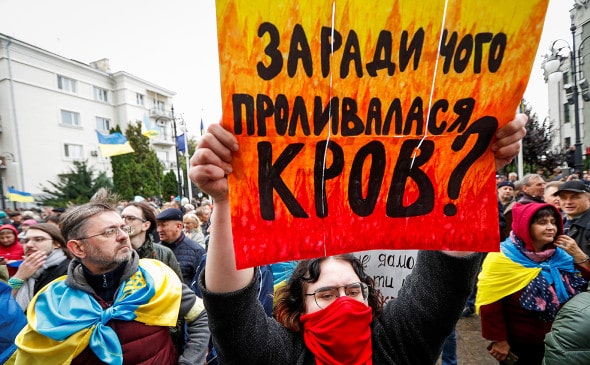
Within Zelensky’s team, there is neither a clear strategy for Donbas nor unequivocal support for the peace process. This was particularly evident in March 2020 following the announcement of the establishment of an Advisory Council to the Trilateral Contact Group. When it became known that representatives of the L/DPR were to enter the Consultative Council, parts of “Servant of the People”, Zelensky’s party, rebelled.
Equally important is Zelensky’s lack of total control over the Ministry of Internal Affairs, headed by Arsen Avakov, who was minister for all five years of Poroshenko’s presidency. During this time, he completely subordinated the ministry to himself, put his people in key positions and “cleared the field” of competitors. Now his influence has increased even more, going beyond the boundaries of the Ministry of Internal Affairs. Avakov’s removal from office may lead to a complete loss of the president’s control over the repressive apparatus for some time, which is very risky for the current administration. At the same time, the end of the war is not in Avakov’s interests – the cessation of hostilities will not in any way increase his approval ratings, but may allow Zelensky to remove him.
Zelensky is thus interested in the peace process, but at the same time depends on Avakov’s loyalty. A striking example of the consequences of this situation is the case of Sergiy Sivokho, who had support from Zelensky to create a civic platform dialogue with representatives of Donbas, including those from uncontrolled territories. In March 2020, the presentation of the platform was disrupted by representatives of the ultra-right party National Corps, created out of the Azov Battalion, whose patron is Avakov. The police did not interfere with the breakdown, and Sivokho was dismissed from the post of adviser to the secretary of the National Security and Defence Council of Ukraine as a result.
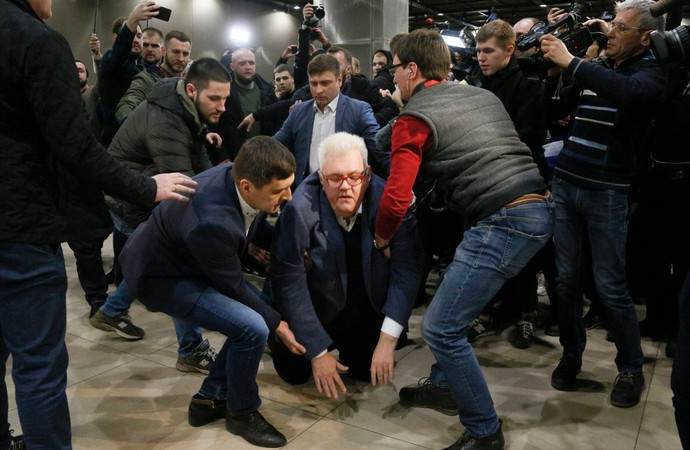
Sergiy Sivokho
Peace nevertheless remains popular among the general population. According to opinion polls, protests against Zelensky’s peace initiatives were supported by about 25 percent of Ukrainian citizens. The majority at this time supported Zelensky’s policies, including the withdrawal of troops in three sections of the front line. As for the desired future, about 60 percent of Ukrainians are in favour of returning territories on the same terms as they were part of Ukraine before the war. The majority of Ukrainian citizens agree that concessions must be made to establish peace, but none of the specific issues on which a compromise is possible enjoy majority support, including special status for certain areas of Donetsk and Luhansk regions.
Of the four options for resolving the problem, namely (1) continuing the war to a victorious end, (2) reintegrating on the terms of autonomy, (3) abandoning these territories, and (4) ending hostilities and freezing the conflict, the latter has the greatest support among Servant of the People voters. At the same time, the percentage of those who agree to a special status increases to almost 50 percent if this is set as a necessary condition for the cessation of hostilities. This complicates the situation for the government, as a significant part of society expects peace but does not want to make significant concessions.
The Peace Process in a Pandemic
Perhaps the main impact of the coronavirus pandemic on the peace process is the diminishing importance of the issue for the population of Ukraine. During the troop withdrawal and a meeting in the Normandy format in Paris in October–December 2019, support for Vladimir Zelensky and the government rose. This indicated that peace was a major priority for the people of Ukraine. But with the onset of the economic crisis, the question of survival has grown much more important as job losses accelerate. Zelensky’s support will now depend more on his success in fighting the pandemic and economic crisis.
It is worth noting that economic problems hindered the peace process even prior to the pandemic. Thus, in early February, the parliament rejected an important bill intended to simplify the receipt of pensions by residents of uncontrolled territories, because its implementation required an additional 4.2 billion US dollars.

No less important are the changes in Donbas. With the start of quarantine, Kyiv, Donetsk, and Luhansk closed the border on both sides. This hit the local economy hard, making it impossible for residents of uncontrolled territories to receive pensions and social benefits, and strengthened the mutual isolation of the two parts of Donbas. Checkpoints are now being gradually opened, but the process is being slowed down by the DPR.
During the quarantine, significant changes took place in the behaviour of the Ukrainian delegation at the Minsk contact group negotiations. They returned to the principle of the Poroshenko era, according to which security issues must be resolved prior to political matters. But a complete return to the policy of 2017–2018 did not happen, and the Ukrainian authorities are trying to find new ways to solve the problem.
To speed up the peace process, an attempt was made in May 2020 to strengthen the Ukrainian representation in the Minsk Contact Group by acting representatives of the government and the Verkhovna Rada. Deputy Prime Minister Oleksii Reznikov became the deputy head of the Ukrainian delegation. One of his most significant innovations was the inclusion of two former Donetsk journalists, Denis Kazansky and Sergei Garmash, in the Ukrainian delegation. They are known for their criticism of any compromise with Russia and the separatists and are perceived negatively by representatives of the L/DPR. At the same time, the Ukrainian authorities want internally displaced persons and not officials of the L/DPR to be the representatives of certain areas of Donetsk and Luhansk regions, with whom, according to the Minsk agreements, it is necessary to consult on holding local elections.

Oleksii Reznikov
The behaviour of the Russian government and separatists is also ambiguous. On the one hand, the dismissal of Vladislav Surkov in early 2020 and the appointment of Dmitry Kozak to the post of Deputy Head of the Administration of the President of the Russian Federation can be seen as a rejection of a more confrontational approach towards Ukraine. On the other hand, Kozak announced the desire to end negotiations at the level of cabinet advisers within the framework of the Normandy format. At the same time, the L/DPR leadership has taken several steps that can be seen as a demonstration of a reluctance to reintegrate into Ukraine by local elites, such as revoking Ukrainian’s status as a state language. Their reintegration threatens uncertainty, but they are controlled by the Kremlin and are unable to seriously affect the peace process.
In general, recent actions and statements of the Ukrainian authorities indicate a reluctance to make further concessions. The Russian government, in turn, does not want to make concessions and demands that Ukraine simply fulfils its obligations.
Prospects for Peace
The socio-economic cost of the conflict continues to grow – Ukraine has planned a record defence budget of 6 percent of the country’s GDP for 2020. Economic losses at the beginning of the conflict comprised at least 15 percent of the country’s GDP. Not to mention that all this happens in the context of financial dependence on the IMF, which has intensified even more amid the impending economic crisis.
At the same time, the socio-economic situation in the L/DPR is even more difficult. Economically the two republics are completely dependent on Russia, but Russian policy is gradually leading their industry to complete collapse. For example, the Vneshtorgservice company – a de facto Russian company registered in South Ossetia and run by Ukrainian oligarch Kurchenko, who fled Ukraine in 2014 – was granted management of a significant part of the “nationalized” industry, yet has incurred massive debts to enterprises and the state budget of the L/DPR. According to the Russian broadcaster RBC, in November 2019 these debts amounted to about 400 million US dollars. In June 2020, wage arrears provoked protests by miners in the LPR. Authorities responded with repression against trade union activists, but at the same time paid off part of the debt.

The economic situation may eventually force the conflict parties to make concessions, but even this does not provide grounds for optimism. Rapid reintegration pressured by circumstances and the West could destabilize the political situation and provoke an escalation of violence. This problem can only be dealt with by a strong government with the support of the majority of the population—a distant prospect.
In recent months, the Servant of the People group in parliament has gradually slipped out of the president’s control. Zelensky is still the country’s most popular politician, but public trust in him is falling, as is support for his party. In this context, support for two extreme political forces is growing – Poroshenko's European Solidarity on the one hand, and the “Opposition Platform – For Life” on the other. The latter declares its readiness to make any concessions to achieve peace, but is perceived by a significant part of the Ukrainian public as pro-Russian. If a political alliance between Zelensky and Opposition Platform – For Life were to be established, he could face a much larger revolt within Servant of the People than after the announcement of the establishment of the Advisory Council.
The situation is complicated by the specific structure of Ukrainian civil society, which has two main wings – the far-right and the national-liberal camp. Despite occasional conflicts between them, their de facto union has only grown stronger over the past year. The war in Donbas strengthens this alliance and anti-Russian sentiments in society. In a war situation, it is easy to accuse someone of being pro-Russian and discredit them and, accordingly, neutralize or reduce their political influence. All this contributes to the fact that the cultural policy of the authorities is gradually becoming more nationalistically exclusive, which complicates the reintegration of residents of the uncontrolled territories into Ukrainian society.
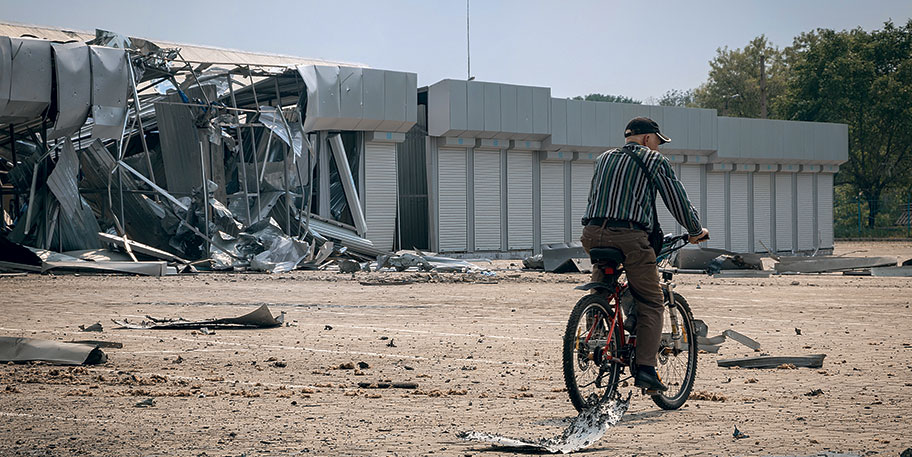
Nevertheless, the war in Donbas must not be forgotten. About 3 million people continue to live in the conflict zone and the uncontrolled territories. The territory on which the conflict is being held can at any moment turn into an environmental catastrophe zone, with long-term negative consequences beyond the region. The war is one of the main factors hindering Ukraine’s development.
Under conditions where rapid reintegration is not possible, a complete cessation of hostilities should be the top priority. Perhaps the only way to achieve this is to send an international peacekeeping contingent to Donbas, such as in the form of a police mission under the auspices of the OSCE. The cessation of hostilities would make a fundamentally different policy towards Donbas possible.
It is also necessary to exert pressure on Kyiv over human rights issues, including the protection of civilians in the conflict zone. Social and cultural policy should become more inclusive towards residents of the L/DPR. State agencies should stop funding far-right organizations, and law enforcement should not condone them. On the other hand, it is necessary to put pressure on the Russian authorities over human rights and access for international organizations on the territory of the L/DPR controlled by them.
It is necessary to open new checkpoints, simplify the procedure for crossing the demarcation line, and gradually lift the economic blockade. In general, it is necessary to restore ties between the territories controlled and not controlled by Kyiv, the mutual isolation between which gradually increased during the war years. All of this will eventually create a new political reality in which reintegration will become possible.
This article is based on publication for the Rosa Luxemburg Stiftung and the GUE / NGL Left faction in the European Parliament
Translation by Viktoriia Muliavka.
